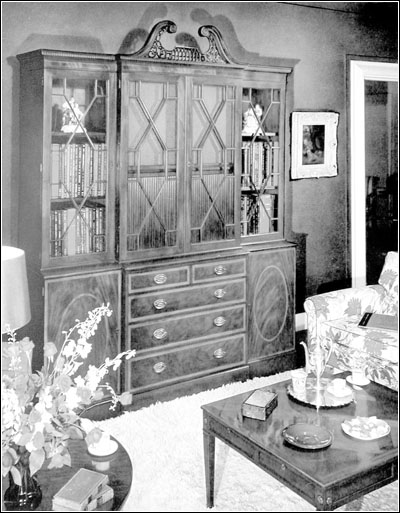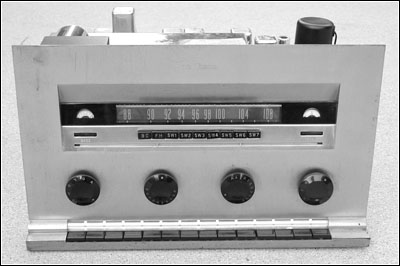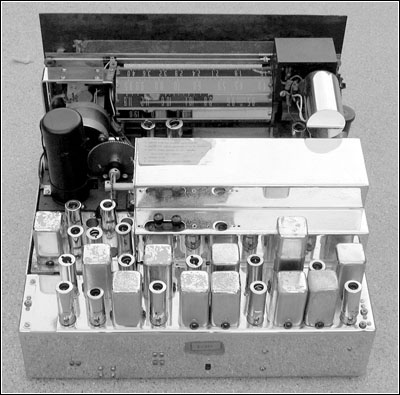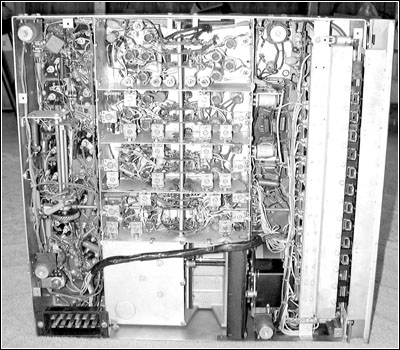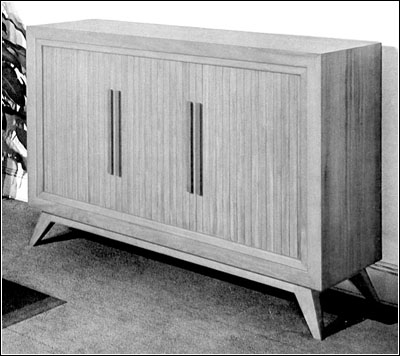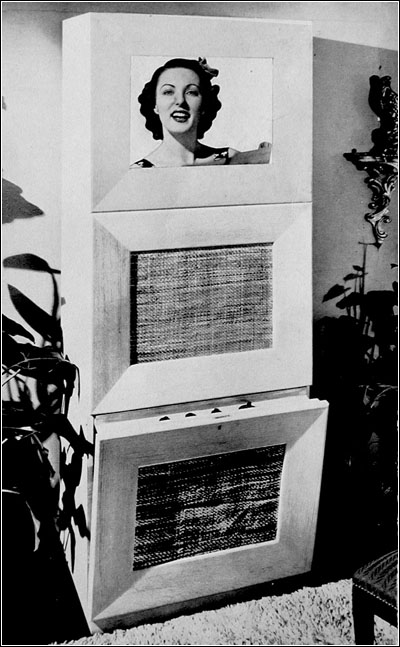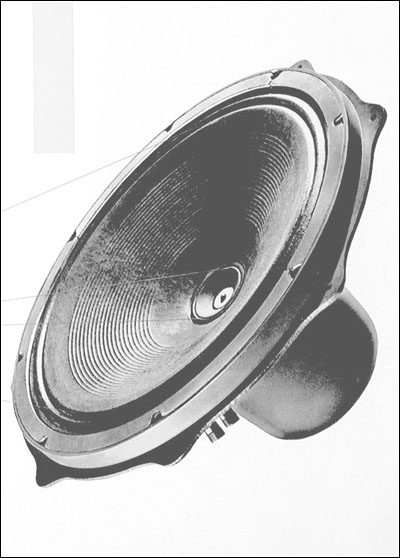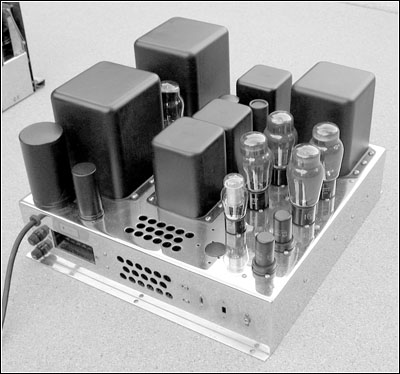Of Old Radios And Related Items--Published Monthly
The RCA Berkshire Line
High Fidelity for the WealthyBY NORMAN S. BRAITHWAITE
Web Edition
In 1947, RCA entered the high-end market with its Berkshire line of radio-phonographs and TVs. In this article, Norman Braithwaite describes these sets and how RCA introduced the Berkshire line to the public. (Editor)
During the Depression years most radio corporations relied on mass production of low- to mid-priced receivers for their success. Some radio companies such as E.H. Scott Radio Laboratories and Capehart thrived on marketing radios to the wealthy. Others, including Philco, RCA, Stromberg-Carlson and Zenith, also marketed to the wealthy by offering custom-built and elaborate receivers in addition to their main product lines. At least one company specializing in elaborate and custom receivers, McMurdo Silver, Incorporated, did not survive the Depression due to the pressures of competition.
Although faced with competition in a limited market, RCA decided to enter the high-end radio game. The story behind this decision and a description of some of the products are the focus of this article. One model, the Berkshire Breakfront, a combined radio/phonograph/TV is shown in Figure 1.
As the United States became more involved in the war in Europe, the supply of materials used for manufacturing radios was diverted to manufacture of war products. Production of radios for civilian use came to a halt. Radio manufacturing facilities were retooled and electronic engineers and assemblymen were reassigned and retrained to produce war products. Tremendous advances in electronic circuit design and manufacturing processes resulted from the war effort. When the war ended late in 1945 and contracts for military products were abruptly terminated, radio manufacturers faced many challenges reestablishing a position in the civilian market.
Figure 1. This reproduction 18th century cabinet housed the Breakfront model that contained a radio, phonograph, and projection-type TV. It was big and measured 94"h x 75 3/4"w x 22 1/2"d. It sold for about $4,000.PostWar Demand
The postwar economy was driven by a very substantial demand for new products by returning military servicemen, as well as the general public. Because of this demand and the cost of retooling for civilian products, the cost of new products had approximately doubled since before the war. When it came to radio receivers, there was a demand for receivers that were capable of receiving the new noise-free FM transmissions. Those that could afford one wanted a television receiver. Companies in the business of manufacturing radios increased their market share by offering receivers with the new FM broadcast band, television, and full-featured consoles.
After the war, Scott Radio Laboratories, formerly E.H. Scott Radio Laboratories, and Capehart under the ownership of Farnsworth, continued to offer their top-of-the-line combination consoles to the wealthy. Scott Radio Laboratories also continued to offer custom-built installations designed around their chrome-plated Model 800B chassis. New companies also entered the custom-built market for the wealthy. Among these were the Fisher Radio Corporation, offering an elaborate high-fidelity console comprised of components that could be purchased individually, and Radio Craftsman offering chrome-plated tuner, amplifier, and television chassis for custom installations.
Figure 2. This front view of the receiver shows its clean lines and symmetrical layout. The front panel was designed by John Vassos. The meters indicate signal strength and FM station centering. Audio bandwidth is graphically indicated on the white line below the bass and treble thumbwheels below the meters.RCA Surveys the Market
At RCA, Frank Folsom, vice-president in charge of operations at the Victor Division and one time vice-president of Montgomery Ward, proposed the idea that RCA develop and offer a sophisticated custom-built radio as a way to apply considerable experience gained from wartime electronic research.
Seeing a potentially significant market and not wanting to overlook an opportunity, RCA conducted a survey to identify the market for an "ultracostly," full-featured, true high-fidelity receiver/phonograph/television combination in designer consoles, or for custom installation. The survey indicated two groups would buy such an offering: the wealthy and the music lovers "willing to spent a disproportionate portion of their incomes on a super deluxe music maker." Further, another survey indicated that almost three-fourths of purchases would be made by or directly influenced by women.
This latter survey justified RCA's selection of Harriet H. Higginson, formerly in charge of Montgomery Ward's fashion merchandise program, to be head of the ultracostly receiver program. Marvin Hobbs, formerly chief engineer responsible for development of FM receivers at E.H. Scott Radio Laboratories, was retained in a consulting capacity as the chief engineer of the Berkshire project.
RCA's ultracostly receiver concept was to design and build an easy-to-use, full-featured, designer receiver using the best possible parts regardless of whether or not the parts were manufactured by RCA. Features were to include full AM coverage from the broadcast band through 22.5 megahertz, bandspread on foreign shortwave broadcast bands, FM broadcast band coverage, a high quality automatic record changer, a powerful high fidelity amplifier, a high quality speaker in a true high fidelity enclosure, and, for those who could afford it, a large screen television receiver. The receiver was to be designed with the capability of remote operation in the future. The combination would be offered in designer consoles for custom installation.
Figure 3. A rear view of the tuner chassis with the bandswitch tuning mechanism at the top left of the photo, the rotating dial scales top center, and the tube layout at the bottom.Berkshire Debut
To attract the attention of the wealthy and music lovers willing to spend a disproportionate portion of their income, it was believed that introduction of such a receiver should not be understated. RCA chose the famous Berkshire Music Center (now called the Tanglewood Music Center) in Lenox, Massachusetts, for the unveiling. RCA did, indeed, introduce the receiver in style! To an all-expenses-paid crowd of 80, a third of whom were press agents, RCA unveiled the receiver on July 29, 1947, in a very lengthy presentation with full theatrical pageantry.
The highlight of the presentation occurred when Serge Koussevitzky, conductor of the Boston Symphony Orchestra playing Beethoven's "Egmont," held up his hand and stopped the orchestra. To the astonishment of the audience, the selection seamlessly continued from a recently recorded version by Serge Koussevitzky and the Boston Symphony Orchestra (recorded earlier at Tanglewood) being played on the new receiver. In exchange for the use of the Berkshire name, RCA committed the profits from the first 200 "limited edition" sets for scholarships to the Berkshire Music Center. If the initial offering was a success, RCA would offer additional models with more features during future years.
Berkshire Components
The high fidelity speaker for the set was selected from a field of five high quality speakers by a group of acoustic engineers and Leopold Stokowski, the famous conductor of the Philadelphia Orchestra. One of RCA's own speakers, the Model MI-11411, better known as the LC-1 or LC-1A, designed by Harry Olson, was selected in a blind listening test. All speakers were previewed in identical cabinets.
Phonographs offered with the combination included the Thorens CD-40 or Garrard RC-65, and an RCA 45-rpm record changer as an accessory housed in an attractive wood "treasure chest" cabinet. No LP record changer or turntable was offered. The LP was a competitor's product.
Design and construction of the receiver was contracted to ARF Products, Incorporated, of River Forest, Illinois. ARF Products was a small firm best known for research, development, and production of sophisticated military electronic equipment from the 1940s through the 1970s.
The Receiver
The receiver control panel, shown in Figure 2, was designed by John Vassos well known for the design of Chrysler vehicles from the late 1950s and early 1960s.
Although well presented and in designer consoles, from a technical perspective, the Berkshire was unusual, but not revolutionary. To a great extent, the receiver and amplifier chassis were built in a manner similar to military equipment. A top and rear view of the chassis is shown in Figure 3. The receiver chassis included several sub-chassis assemblies one of which was a Collins Auto tuner. This was a motor-driven tuner with notably accurate and repeatable preset capability designed for aircraft transmitters by Arthur Collins of Collins Radio Corporation during the late 1930s. A close-up of the motor-driven bandswitch mechanism is shown in Figure 4 (see print version).
Figure 7. The bottom shield has been removed to show the complexity and component density of the tuner chassis. Maintainability was not high on the designer's list of features.Both the AM and FM receivers included two stages of RF amplification. The AM receiver contained four stages of intermediate frequency amplification, and the FM receiver contained three stages of intermediate frequency amplification. The FM receiver included a ratio detector to avoid patent infringement of Armstrong's superior discriminator circuit.
Figure 5 (see print version) provides a look at the FM tuner portion of the chassis, while Figure 6 (see print version) shows the 4-gang tuning capacitor used for AM tuning. The complexity of the tuner chassis is shown in Figure 7.
In blatant defiance of Armstrong's patent, however, and much to the discouragement of Armstrong, RCA used the discriminator circuit in the television receiver chassis for detecting the FM sound carrier. The filaments of all tubes on the radio tuner chassis were operated on direct current. The 85-pound audio amplifier/power supply was designed to develop 40-watts "undistorted" and 50-watts maximum output from four Type 6L6G tubes in conventional, fixed bias, push-pull parallel pentode operation.
A total of 33 tubes was used in the radio receiver, and 35 additional tubes were used in the projection television receiver. Power required for radio or phonograph operation was 400 watts and for television operation, 900 watts. The receiver was designed to be operated from 110- or 220-volts AC, 50 or 60 hertz.
Figure 8. The Modern model was used at the now famous demonstration at the Berkshire Music Center. It too was a radio-phonograph.Designer Cabinets
Customers were offered a choice of five designer consoles. The most elaborate were the eighteenth century "Breakfront" console weighing 720-pounds and a "Secretary" console, both designed by William Millington of Baker Furniture, Incorporated. The Breakfront console is shown in Figure 1 earlier in this article.
The "Modern" and "Contemporary" consoles were designed by T.H. Robsjohn-Gibbings and a "Regency" console was designed by Edward Wormley. The Modern, shown in Figure 8, bears a strong resemblance to the low, wide television combinations offered 20 years later. Other cabinet styles included the "Contemporary" model and the "Regency" model, shown in Figure 9 (see print version). These models were radio-phonographs.
Figure 10. The Clubman was housed in a custom cabinet and included a projection TV. It was especially designed for the Knickerbocker Club in New York, according to a sales brochure.In addition to these standard models, the Berkshire line offered custom cabinets, such as the "Clubman," also including a projection television set, shown in Figure 10.
Ease of Operation
As promised, the radio receiver was designed for ease of operation. Controls included a volume control, noise suppressor control, selectivity control, manual tuning control, radio station keyboard and band keyboard. Instructions for the controls were clearly and simply written for a nontechnical owner. Switching between the AM bands, FM, television and phonograph operation was accomplished from push buttons using a motor driven bandswitch and drum dial indicator. A second motor was used to operate the tuner and station indicator when selecting a station using push buttons.
Other indicators included a signal strength meter, FM tuning meter and "calibrated tone scale" for indication of bass and treble cutoff. A total of 10 presets was available for user programmable AM or FM radio stations. Both the bandswitch and tuning motors are engaged when selecting a station using push buttons.
Mechanical and Electrical Shortcomings
In spite of the military style design, the Berkshire had its share of problems. As is often the case with mechanical and electrical items built to architectural designer specifications, and much like the Vassos designed automobiles of the late 1950s and early 1960s, serviceability was not a priority. As a consequence, replacement of some dial lamps requires removal of the front panel (a substantial effort).
Deviations from usual military construction practices also contributed to difficulty servicing. The wiring harness was installed below the subassemblies instead of next to the chassis. This construction practice, along with the fact that the wiring harness was of plastic insulated wire, makes servicing nearly impossible without damage to the wiring harness.
Component board subassemblies were constructed with components on both sides. However, instead of routing leads of backside components around the end of the component board to solder posts, the leads were routed through the "eyelet" holes of solder lugs wrapped around the solder lug and soldered to the lug through the eyelet. This makes removal and replacement of components on the backside of circuit boards very difficult. More annoying was the requirement of removing the entire push-button assembly in order to service the audio circuits of the receiver.
In addition to poor serviceability, the shortcomings of the Berkshire receiver included poor tracking on the FM band (disparity between frequency of received FM signal and dial indication), narrow ratio detector bandwidth (less than one-half of the IF bandwidth rather than twice the bandwidth generally considered necessary), inefficient receiver audio output circuit, and a short-lived selenium rectifier used for the filaments on the tuner chassis. Although the audio amplifier of the Berkshire was capable of developing up to 50 watts RMS of audio power, the LC-1 speaker was designed to handle only 20 watts RMS. The LC-1 is shown in Figure 11.
The Berkshire Amplifier
The Berkshire amplifier, shown in Figure 12, was designed with three 15-ohm resistors in series-parallel with the speaker. These resistors were included to limit the power reaching the speaker and to allow the easy addition of accessory speakers by substitution of resistors with the additional speakers. Given this design, the actual power reaching the speaker is 10 watts "undistorted" or 12.5 watts peak, and 3/4 of the audio power developed by the amplifier is dissipated by the resistors as heat.
Additional inefficiency can be attributed to the use of a selenium rectifier for rectifying the filament power for all tubes on the tuner chassis. As the selenium rectifier aged, the efficiency of the rectifier would decrease resulting in reduced voltage supplied to the filaments. The replacement of this rectifier was straightforward when the correct selenium rectifier component was available. However, today, replacement of the rectifier with diodes requires the addition of a substantial size series resistor or some clever rewiring of the transformer circuits supplying the tuner filaments. With the possible exception of FM tracking, the purchasers of the receivers were largely unaware of these problems.
Marketing Results
RCA was able to sell substantially all of an initial run of 500 receivers contracted from ARF Products. Profits from the sales did not recoup project development costs, and the project fell out of favor with RCA management in Camden. Apparently, there was enough interest in the receiver, however, for RCA to inquire about another run of chassis from ARF Products. If RCA could sell more of the receivers at a better profit margin, they could recoup their development costs, establish the company as the market leader for the product, continue the line of receivers, and turn a profit on the receivers.
Figure 11. The LC-1 loudspeaker designed by Dr. Harry F. Olson. These speakers are selling for about $500 and are still in demand.RCA entered discussions with ARF Products for a second run of chassis to be provided at a lower cost. ARF Products had not profited from its contract for the first run, and, even if the cost of constructing the chassis were covered, RCA's lower offer for the second run did not allow ARF Products a satisfactory return. Consequently, no new contract was entered and no more "ultracostly," full-featured receivers were built by RCA.
Among the general public, including "music lovers willing to spend a disproportionate portion of their income," interest in the elaborate, full-featured combination receivers was waning due to the introduction of high-fidelity components. The high-fidelity components and component television chassis allowed consumers great flexibility in assembling an entertainment system to meet their particular interests. In a short time, the RCA Berkshires, E.H. Scott 800 Series, Capehart 400 Series, and a few other top-of-the-line, full-featured combination receivers were replaced by Brook, Fisher, Radio Craftsman, H.H. Scott (not related to E.H. Scott), and a few other manufacturers' components.
Although wealthy consumer interest supported limited production of an ultracostly, full-featured receiver, RCA's Berkshire failed on an economic basis. Neither ARF Products nor RCA was content with its profits, and RCA did not believe it could maintain sales if it were to raise the prices of the receivers enough to make the project profitable. The military practices of design and construction that allowed manufacture of large quantities of serviceable, high reliability receivers for the military, understandably, were not cost effective for small runs of consumer receivers.
Since RCA had wisely implemented the project using contracted services and minimal staff, with the exception of the project cost, the economic failure of the project did not reflect substantially on the company's image. RCA did not feature the receiver in advertising as many companies are prone to do with their benchmark products, and no mention of the receiver was included in the recently published RCA history His Masters Voice in America.
Figure 12. This view of the power supply/power amplifier chassis shows plenty of iron on a chrome-plated chassis. Four Type 6L6G tubes are used in push-pull parallel.Berkshire Collectibles
Today, the RCA Berkshire receivers are very difficult to find, especially in an original cabinet. Most surviving chassis have some degree of cosmetic distress, and all will require electronic service if not previously conducted. Given the very congested circuit and complex electro-mechanical systems, the tuner chassis is not a good candidate for replating. In addition to repair of specific problems as required, rebuilding of the push-button assembly, replacement of wax-paper capacitors, and alignment are required for reliable operation of the receiver.
Even if not working, the Berkshire is considered very collectible. Nonworking Berkshire chassis set in fair to good condition offered on eBay during the past few years have commanded prices around $1,000 for the tuner chassis and approximately $500 for the LC-1/LC-1A speaker.
A complete Berkshire in a breakfront console with a matching dining table and six chairs (table and chairs by a different furniture maker), all in excellent unrestored condition, recently changed hands for many thousands of dollars in a private sale. While these prices may appear high for a postwar receiver, very few opportunities exist for purchasing a Berkshire receiver, and the value of these receivers is not likely to go down.
References:
Albuquerque Journal, June 16, 2000.
Barnum III, Frederick O. His Masters Voice in America, First Printing. Camden, NJ: General Electric, 1991.
Braband, Ken C. First 50 Years, A History of Collins Radio and the Collins Divisions of Rockwell International. Cedar Rapids, IA: Rockwell International Publisher.
"Golden Ears and Tin Ears," Newsweek, August 11, 1947.
Hobbs, Marvin. E.H. Scott, Dean of DX, Second Edition. Mendon, N.Y.: Radio Daze Press, 2002.
Lewis, Tom. Empire of the Air, The Men Who Made Radio. New York: T. Harper Collins Publishers, 1991.
RCA Berkshire Series, RCA, undated (large sales book).
RCA Victor Berkshire, AM-FM Tuner Unit TU-1, Phonograph Pre-Amplifier PPAU-1, Audio Amplifier and Power Supply Unit AAPU-1 Service Data, First Edition, First Printing, Publication Number CCP-2, RCA, 1948.
RCA Victor Berkshire "Breakfront" Models B1-A, B1-B, B1-C Radio-Phonograph-Television Combination Service Data, First Edition, First Printing, Publication Number CCP-1-49, RCA, undated.
"Super Radio Set," Business Week, July 26, 1947.
Special thanks to Marvin Hobbs and John Baldwin for information about the relationship between RCA and ARF Products.
In 1975, Norman Braithwaite, a civil engineer, began collecting antique radios, especially those manufactured by E.H. Scott and its competitors. His collection includes representative sets from 1917 to 1960, the prize being a rare Scott 48-tube custom receiver.
| [Free Sample] [Books, etc., For Sale] [Subscribe to A.R.C./Renew] [Classified Ads] [Auction Prices] [Event Calendar] [Links] [Home] [Issue Archives] [Book Reviews] [Subscription Information] [A.R.C. FAQ] URL = http://www.antiqueradio.com/Dec07_Braithwaite_RCABerkshire.html Copyright © 1996-2007 by John V. Terrey - For personal use only. Last revised: December 1, 2007. For Customer Assistance please contact ARC@antiqueradio.com or call (866) 371-0512 toll free Pages designed/maintained by Wayward Fluffy Publications
Antique Radio Classified |
